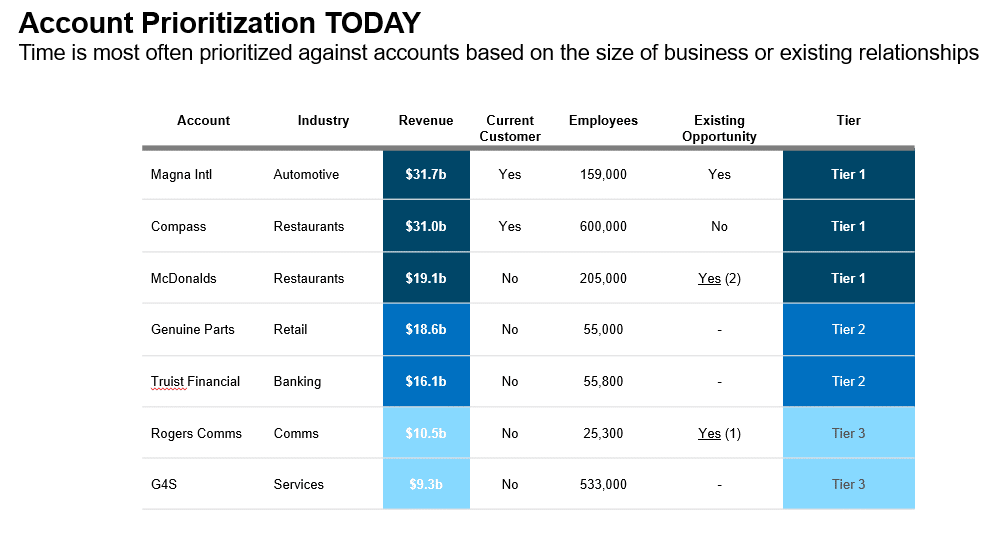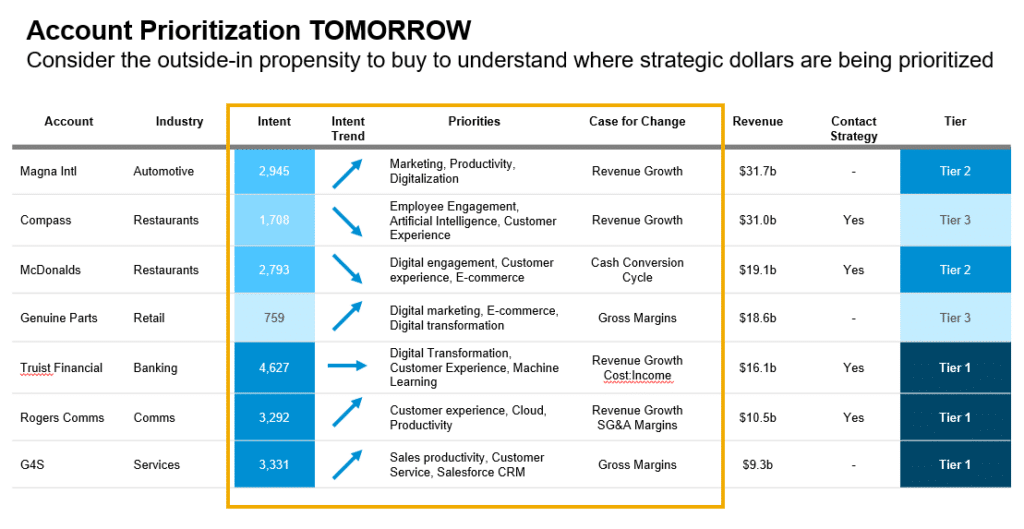Reading Time: 4 minutes
3 Must-Haves for a Winning Go-to-Market Strategy
Anand Shah

In my role at Databook, I regularly have the opportunity to identify ways to improve the sales and go-to-market strategies of the leading enterprise sales companies. And while some are well crafted and already executing well, there are three common challenges I see most often: account prioritization, integrated GTM motions, and tracking success. I’d like to briefly explain why these are common challenges—and how companies are revising their GTM approaches to achieve more wins.
Prioritization: Where big is not always better
One of the biggest challenges for sales organizations—and, by extension, the entire go-to-market team—is an incorrect assumption that sets them up for potential loss right out of the gate. The assumption is that the bigger a company is, either in headcount, sales or income stream to the business, the greater its TAM. But just because a customer signed a big deal last year doesn’t necessarily make them a top prospect this year. A common fallacy is to focus heavily on the biggest accounts, which leaves less time for other high propensity-to-buy prospects.

This kind of prioritization has dire consequences for the sales team:
- The “bigger is better” approach frequently leads to unbalanced territories, since there is weak correlation between bigger accounts and propensity to buy this year.
- An increasingly skewed territory configuration disengages Account Executives who have no hope of making a quota, and they wind up leaving the company in search of better opportunities. Customers say that a lost Account Executive translates to a $1M to $1.5M hit to the bottom line (including the full costs of hiring, ramp time and the opportunity cost in the intervening period).
Databook sees an opportunity for companies to increase pipeline by 2-3x simply by focusing on the right accounts. We believe companies should prioritize accounts based on their actual propensity to buy, as evidenced by hard data that realistically depicts management intent. That doesn’t always align with the size of the business. In fact, in some cases, smaller companies might be more ready to make a multi-million dollar purchase than their larger counterparts. The most productive sales team we have seen generated $350M in one year with only 6 sellers—and most importantly, only a small handful of their customers were Global 2000 accounts. The trick is being able to quickly analyze and understand real-time prospect data, so you know with high certainty how to allocate your team’s time and resources.

Integrated GTM motion
As you might have guessed, when you start out prioritizing the wrong accounts, the whole go-to-market team suffers. It’s not that people are misunderstanding their role in the process, it’s that they’re misunderstanding the customer—and that’s a huge opportunity lost. Customer centricity is the heart of modern business. To do a quick health check for your organization, take a look at the account prioritization list from the beginning of the fiscal year (assuming one exists) and then compare it to the fiscal year to date activity report by account from your CRM. Are the two lists aligned?
How do we become more customer-centric? By listening. By ingesting the data and messages the customer or prospect has put out there, and by analyzing that information to understand which way the wind is blowing. This is an area where Databook helps companies excel. Our applications leverage AI and machine-learning algorithms to decipher the underlying trends within a prospect’s strategic priorities, for example, or the deeper insight behind their financial case for change. Every piece of the puzzle is out there, and each one tells a story. Databook helps you assemble those pieces to see a bigger and more meaningful picture.
When the go-to-market team has that kind of insight at hand, it’s amazing how their business acumen elevates and productivity shifts into gear.
Tracking success: How we keep improving
Of course, we can’t forget that the actions you take to bolster your sales and GTM strategies aren’t “one and done” tasks. Your goal—one that’s so often overlooked—is to learn from past mistakes and replicate successes where it makes sense. You have to keep things moving at all times, so you can continue to generate pipeline, leverage best practices, engage with customers from their point of view, and work to close.
Any tools or techniques you apply in your strategic planning are useless in the long run if they don’t lend themselves to being both scalable and repeatable. Scalability ensures you can grow your deals and adapt on the fly to customers of any size. For example, and hopefully you have that activity report by now, take a look at the number of outbound emails sent by your senior Account Managers. Surprisingly, outbound engagement is typically very low across most enterprise sales organizations. Why? The SDR/BDR role was set up so AMs don’t believe it’s their job. Wrong. The most successful reps are, in fact, drafting emails for their senior leadership to send to the line of business executives of their top target accounts. Try it out, and see the results! Measuring successes (and losses) ensures you can create a flywheel effect that naturally restarts and continues the sales cycle over and over again.
Of course, not every technology platform out there was built to deliver on these vital elements without compromise. Look specifically for applications that provide the following:
- Visibility. You don’t just want pretty dashboards; you need intuitive tools for managers and executives that guide the entire process. Quick-glance visuals, generated through real-time data analysis, help you rapidly determine where to focus, what’s next, and who’s reaching their goals. This is how you prevent gridlock and keep the cycle going.
- Automation. You need tools that automatically handle time-consuming chores, like sales deck creation or outreach emails to prospects. Automation gives you both the speed and the accuracy you need to execute critical tasks without delay.
- Personalization. This is how you tie it all together, because visibility and automation on their own are powerless. You need tools that leverage data to define a customer’s point of view and then apply that POV across the cycle, so that every auto-generated presentation, every email, every interaction is necessarily infused with that one-to-one perspective.
In my experience, effective go-to-market and sales strategies must cover all these bases—from the right prioritization to a deep customer focus—while ensuring measurement exists to keep results continuously improving. Databook was built with these things in mind.













